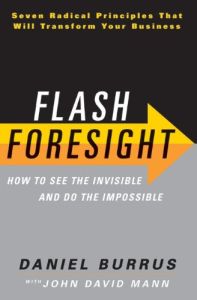
Flash Foresight
How to See the Invisible and Do the Impossible
ISBN: 9780061922299
Pages: 304
Recommendation
If you’re like most people, you’re trying to deal with the changes life throws at you every day, and you could use some help planning for the future. Technology forecaster and strategic adviser Daniel Burrus, writing with business author John David Mann, shows you how to see invisible opportunities and solve seemingly impossible problems by developing your ability to generate “flashes of foresight.” He demonstrates how to turn rapid change into advantage by using strategic foresight and certainty. As the subtitle says, Burrus believes you can learn to look where no one else is looking to “see the invisible and do the impossible.” getAbstract recommends their enthusiasm and vision to innovators, leaders and to anyone planning ahead.
Summary
About the Authors
Technology forecaster, strategic adviser and entrepreneur Daniel Burrus is the author of Technotrends. Business writer John David Mann is the co-author of The Go-Giver.








Comment on this summary